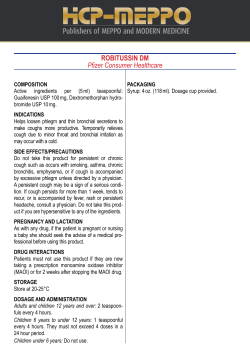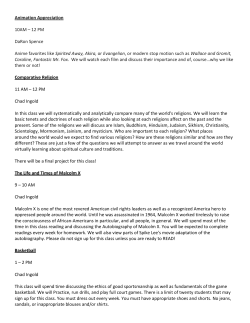
How to Solve Drug Dosage Problems
How to Solve Drug Dosage Problems *General Information ----------------------------------------- ------ ------------------ pg 2 *Converting between units ------------------------------------------------------------ pg 3 *Converting between metric units ---------------------------------------------------- pg 4 *Calculating Drug Dosages ------------------------------------------------------------ pg 5 * Ratio-proportion method * Formula method *Other Formulas --------------------------------------------------------------------- pg 6-7 * Calculating BSA * Calculating a child’s dosage from an adult dosage * Calculating flow rate in ml/h * Calculating flow rate in gtt/min * Converting from °F to °C or °C to °F *Helpful Websites ----------------------------------------------------------------------- pg 8 Provided by Tutoring Services 1 How to Solve Drug Dosage Problems General Information There are 3 different types of measurements you will encounter when dealing with medications: Household, Apothecary, and Metric. Type Number Solids Liquids Household Whole numbers and Fractions before unit. Ex: 1 ½ T Teaspoons (tsp, t) Tablespoons (Tbs,T) Pounds (lb) Whole numbers, Fractions, and Roman Numerals after unit. Ex: gr 15 ½ or dr iss Whole numbers and decimals before unit (always put a 0 in front of the decimal. Ex: 0.15 mL Grains (gr) Drams (dr) Drop (gtt) Ounce (oz) Cup (c) Pint (pt) Quart (qt) Glass Minum (m) Fluid Dram (dr) Apothecary Metric Grams (g) Meter (m) Liters (L) Note: When more than one equivalent is learned for a unit, use the most common equivalent for the measure or use the number that divides equally without a remainder. Common Conversion Factors m 15 = 15 gtt = 1 mL = 1 cc 4 mL = dr 1 15 mL = 3 t = 1 T 30 mL = 1 oz 1 oz = dr 8 60 mg = gr 1 1 g = gr 15 2.54 cm = 1 in 2.2 lb = 1 kg Roman Numerals ½ = ss 1 = I or i 2 = II or ii 3 = III or iii 4 = IV or iv (i before v = 5-1) Provided by Tutoring Services 5=v 10 = x 15 = xv 19 = xix [10 + (10-1)] 20 = xx 2 How to Solve Drug Dosage Problems Converting Between Units In order to convert between units, you first begin with the unit you are given. You then find a conversion factor that relates the unit you have to begin with and the unit you need to convert to. Next, you multiply the unit you began with by the conversion factor you found. This calculation will give you the new unit. Ex: Convert 120 mg to gr________ . 1st: think of a conversion factor that relates mg and gr. 60 mg = gr 1 (This can be used as either 60 mg/gr 1 or gr 1/60 mg) 2nd: set up your multiplication equation. 120 mg x gr 1 = gr _____ 60 mg note: when using the conversion factor, always place the unit you need on top and the unit you begin with on the bottom. 3rd: Solve your equation. Multiply 120 mg x gr 1, then divide by 60 mg. 120 mg x gr 1 = 120 120 ÷ 60 mg = gr 2 Therefore: 120 mg = gr 2 If you do not have a conversion factor for the two units you are dealing with you may be able to go through another unit to get to the unit you need. Ex: Convert 3 t to _____oz. 1st: Try to find a conversion factor that relates teaspoons to ounces. If you look at your list, you probably won’t find one. However, we can convert from teaspoons to milliliters and then from milliliters to ounces. Therefore, we need two conversion factors: 3 t = 15 mL and 1 oz= 30 mL. 2nd: set up your equation 3 t x 15 mL = _____mL 3t 3rd: Solve the equations. 3 t x 15 mL = 45 45 ÷ 3 t = 15 mL ____ mL x 1 oz = m_____ 30 mL 15 mL x 1 oz = 15 15 ÷ 30 mL = 0.5mL Therefore: 3 t = 0.5 mL Provided by Tutoring Services 3 How to Solve Drug Dosage Problems Converting Between Metric Units When you convert between metric units, you do not have to multiply anything; you may simply move the decimal place. Kilo .................. UNIT ................. Milli ................. Micro Kilogram ............. Gram ...................... Milligram ............. Microgram Kiloliter ............... Liter ........................ Milliliter ............... Microgram Kilometer............ Meter ...................... Millimeter............ Micrometer 1 ....................... 1,000 .................... 1,000,000........... 1,000,000,000 0.000000001.....0.000001………….0.001……………1.0 There are 3 decimal places between each; therefore you move your decimal places 3 spaces for each conversion. Ex: Convert 25.3 g to __________mg 1st: There is only one space between g and mg, so that means I move the decimal place 3 spaces in the same direction as the chart: to the right. 2nd: 25.3 (move decimal → 3 places) = 25,300 Therefore: 25.3 g = 25,300 mg Ex: Convert 346,720.2 mg to ________kg 1st: You use the same rules for converting from milligrams to kilograms. There are 2 spaces between kg and mg so you move your decimal 6 places (2 spaces x 3 decimal places each). In this case, according to the cart, we move the decimal to the left. 2nd: 346,720.2 (move decimal ← 6 spaces) =0.3467202 kg Therefore: 346,720 mg = 0.3467202 kg Provided by Tutoring Services 4 How to Solve Drug Dosage Problems Calculating Drug Dosages When performing drug calculations, you may use one of 2 methods: the Ratio-Proportion method or the Formula method. Each of these works as well as the other. However, once you decide which you are more comfortable with, you should stick with that way and not try to switch back and forth between the two. Ratio-Proportion: 1st: set up your proportion. 2nd: Multiply means and extremes 3rd: solve for “x” algebraically. Formula: D x Q = answer H order x unit = answer available You use drug calculations when you are calculating the dose of a medication you need to give a patient when you already know the strength of medication that the patient needs. Ex: If the doctor orders 20 mg of Benadryl and you have 10 mg tablets, how many will you give the patient? Ratio-Proportion Method We know that 10 mg = 1 tablet, and we need 20 mg in an unknown number of tablets. So: 1st: set up equation. 10 mg : 1 tab = 20 mg : x tab Notice that on both sides of the equation, mg comes first, then tablets. This is very important. It doesn’t matter which unit comes first, as long as they are in the same order on both sides of the equal sign. 2nd: Multiply means and extremes 10 mg • x tab = 1 tab • 20 mg 3rd: Solve algebraically. 10x = 20 10x = 20 10 10 x=2 Formula Method D x Q =____ H order x unit = ______ available So: 20 mg x 1 tablet = 2 tablets 10 mg Therefore: you would give the patient 2 tablets. Provided by Tutoring Services 5 How to Solve Drug Dosage Problems Other Formulas Calculating BSA (m²) Lb x in 3131 or kg x cm 3600 *Round to hundredths place Ex: If you know a patient weighs 140 lb and 62 inches tall, to calculate the BSA, you simply plug the numbers into the formula, then solve. 140 lb x 62 in 3,131 140 x 62 = 8,680 ____ 8,680 ÷ 3131 = 2.77 √2.77 = 1.66 m² Calculating a child’s dosage using an adult dosage Child’s BSA x adult dosage = child’s dosage 1.7 m² *round to hundredths place Ex: The normal adult dosage of a medication is 150 mg. You have a child that weights 30 kg and is 120 cm. How much medication do you give the child? 1st: You must find the child’s BSA. To do so, use the formula given above. 30 kg x 120 cm = 1 √1 = 1 3,600 2nd: Use the child’s dosage formula. 1 m² x 150 mg = 88.24mg 1.7 m² Calculating Flow Rate in mL/h Total mL ordered = mL/h (must round to a whole number) Total h ordered Ex: Calculate the flow rate for an IV of 1,820 mL Normal Saline IV to infuse in 15 h by controller. Flow rate = _________ ml/h 1,800 mL = 121.33 = 120 mL/h 15 h Provided by Tutoring Services 6 How to Solve Drug Dosage Problems Calculating Flow Rate in gtt/min Volume (mL) x drop factor (gtt/mL) = Rate (gtt/min) Time (min) (MUST be whole number) Ex: The physician orders Lactated Ringer’s IV at 150 mL/h. The drop factor is 15 gtt/min. Find the flow rate in gtt/min. 150 mL x 15 gtt/min = 37.5 = 38 gtt/min 60 min Converting from ºF to ºC or ºC to ºF ºF = 1.8 (ºC) + 32 *Carry to hundredths and round to tenths ºC = ºF – 32 1.8 Provided by Tutoring Services 7 How to Solve Drug Dosage Problems Helpful Websites There are many helpful websites when it comes to drug calculations. The following all have practice problems and solutions. We encourage you to use them to your advantage. After all, the best way to get good at something is to PRACTICE! http://nursesaregreat.com/articles/drugcal.htm http://www.testandcalc.com/drugcalc_legacy/index.asp http://www.unc.edu/~bangel/quiz/quiz5.htm http://home.sc.rr.com/nurdosagecal/ http://classes.kumc.edu/son/nurs420/clinical/basic_practice_.htm http://www.rncentral.com/library/quizzes/dc.html http://e-courses.cerritos.edu/rsantiago/drug_calculations.htm http://www.unisanet.unisa.edu.au/Information/12150info/Remediation%20Practice%20cal cs%202004.doc http://nursing.flinders.edu.au/students/studyaids/drugcalculations/page.php?id=1 Provided by Tutoring Services 8 How to Solve Drug Dosage Problems
© Copyright 2025





















